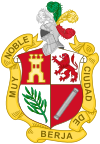Diocese of Vergi
| Berja, Spain | |||
|---|---|---|---|
|
|||
| Coordinates: 36°51′N 2°57′W / 36.850°N 2.950°WCoordinates: 36°51′N 2°57′W / 36.850°N 2.950°W | |||
| Country | Spain | ||
| Community | Andalusia | ||
| Municipality | Almería | ||
| Government | |||
| • Mayor | Antonio Torres López (PP) | ||
| Area | |||
| • Total | 218 km2 (84 sq mi) | ||
| Elevation | 335 m (1,099 ft) | ||
| Population (2005) | |||
| • Total | 14,249 | ||
| • Density | 65/km2 (170/sq mi) | ||
| Time zone | CET (UTC+1) | ||
| • Summer (DST) | CEST (UTC+2) | ||
Berja (Spanish pronunciation: [ˈbeɾxa]) is a municipality, former bishopric and Latin titular see in Almería province, in the autonomous community of Andalusia, southern Spain.
It is located on the south-eastern slope of the Sierra de Gádor, 10 miles north-east of Adra by road.
Berja may have Phoenician or Iberian origins; it was known to the Romans as Vergis or Vergium, and it was part of the province of Baetica. There are Roman remains in the Villa Vieja: an amphitheater and an aqueduct, and mosaics whose style and production are similar to those found in Pompeii and Herculaneum.
Saint Ctesiphon (San Tesifón), patron saint of the town, is said to have preached in the area in the first century, bringing Christianity to the town. From this era are conserved coins, crosses and a sarcophagus found in the neighborhood of Alcaudique, which is now in the National Archaeological Museum (Museo Arqueológico Nacional). A reproduction exists in the Museum of Almería.
The site suffered an earthquake in the fifth century, and the Roman town subsequently dissolved into various smaller communities, one of which –Berja- became the dominant one. After the Moorish invasion of Iberia in the eighth century, the town was known as Berja, and a fortress was built in the town. Remains of Moorish baths can still be seen in the neighborhood of Benejí.
...
Wikipedia


